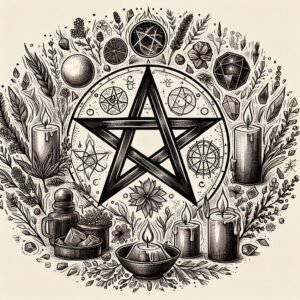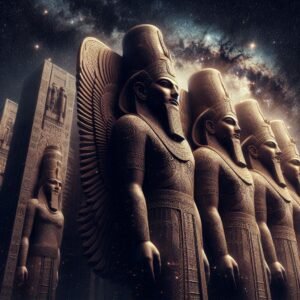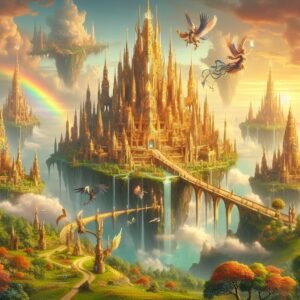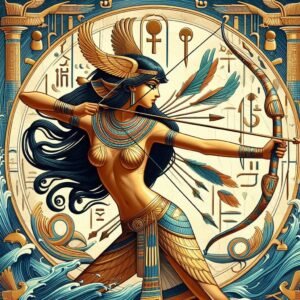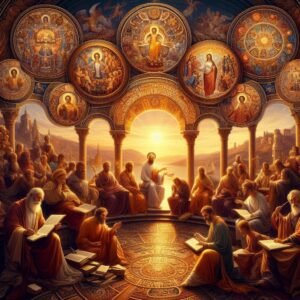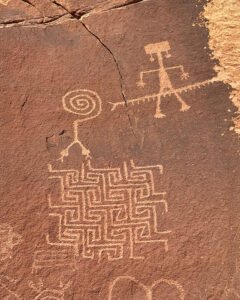
The Sumerian cosmology is a fascinating blend of mythology and early scientific thought. The Sumerians envisioned the universe as a closed dome surrounded by a primordial saltwater sea. The earth was seen as a flat disc beneath this dome, with an underworld and a freshwater ocean called the Abzu beneath it. The sky was personified by the god An, while the earth was represented by the goddess Ki. These two deities produced Enlil, who separated heaven from earth and claimed the earth as his domain.
Humans were believed to have been created by the gods to serve them, maintaining harmony and order in the world. The Sumerians also believed in an underworld called Kur, ruled by the goddess Ereshkigal, where all spirits went after death. This cosmology reflects the Sumerians’ attempts to understand their world and their place within it, blending their observations of nature with their religious beliefs.
The flat Earth
The Sumerians’ cosmology was deeply intertwined with their mythology and religious beliefs. They envisioned the universe as a closed dome, with the sky forming the upper part of this dome, known as An, the god of the heavens. Surrounding this dome was a primordial saltwater sea, representing the chaotic waters of creation. The earth, seen as a flat disc, lay beneath the dome and was personified by the goddess Ki.
Beneath the earth, the Sumerians believed in the existence of an underworld, a dark and dreary place ruled by the goddess Ereshkigal. This underworld was where all souls went after death, regardless of their deeds in life. Additionally, beneath the earth was the Abzu, a freshwater ocean associated with the god Enki, who was believed to reside there. Enki was a god of wisdom, water, and creation, and the Abzu was considered a source of life-giving waters.
This cosmological view reflects the Sumerians’ understanding of their environment and their attempts to explain natural phenomena through their deities and myths. It also highlights the importance of water in their world-view, both as a life-giving force and a primordial element of creation.
Multiple creation myths
The Sumerians had several creation myths that detailed their beliefs about the origins of the world and humanity. One of the most well-known is the “Eridu Genesis,” which describes how the gods created humans from clay to serve them and maintain the earth. This myth also includes a great flood sent by the gods to destroy humanity, with only one man, Ziusudra, surviving by building a boat, similar to the story of Noah.
Another creation myth involves the cosmic births of gods. According to this belief, the primeval waters, personified by the goddess Nammu, gave birth to the earth (Ki) and the sky (An). These two deities then produced Enlil, who separated heaven from earth and took control of the earth. These myths reflect the Sumerians’ attempts to explain their world through divine actions and relationships.
The Eridu Genesis
The Eridu Genesis is one of the earliest known creation myths, dating back to around 1600 BCE. It describes how the gods created humanity from clay to serve them and maintain the earth. The myth also details the establishment of the first cities and the institution of kingship, which were seen as divine gifts to organize human society.
A significant part of the Eridu Genesis is the story of a great flood. According to the myth, the gods became displeased with humanity and decided to destroy them with a flood. However, the god Enki (also known as Ea) warned a man named Ziusudra (or Utnapishtim) and instructed him to build a large boat to save himself, his family, and a pair of every living creature. Ziusudra obeyed, and after the floodwaters receded, he offered sacrifices to the gods, who granted him immortality as a reward for his piety.
Parallels with Noah’s Ark
This myth shares similarities with other ancient flood stories, such as the Epic of Gilgamesh and the biblical story of Noah’s Ark, highlighting common themes in early human attempts to understand and explain natural disasters and divine will.
The Eridu Genesis shares several similarities with other ancient flood myths, such as the Epic of Gilgamesh and the biblical story of Noah’s Ark. In all these myths, a divine being or beings decide to send a catastrophic flood to destroy humanity due to their displeasure with human behaviour.
In each story, a chosen individual is warned about the impending flood and instructed to build a large boat to save themselves, their family, and pairs of animals. This individual, whether Ziusudra in the Eridu Genesis, Utnapishtim in the Epic of Gilgamesh, or Noah in the Bible, follows the divine instructions and survives the flood.
After the floodwaters recede, the survivors offer sacrifices to the gods, who then bless them and sometimes grant them special rewards, such as immortality in the case of Ziusudra and Utnapishtim. These common elements highlight shared themes of divine judgment, human survival, and the renewal of life across different cultures and time periods.
References
https://www.jstor.org/stable/27899374
https://en.wikipedia.org/wiki/Eridu_Genesis
https://mythology.stackexchange.com/questions/305/are-noah-and-ziusudra-the-same-person
https://www.worldhistory.org/video/2597/ancient-flood-legends-and-stories-from-around-the/
https://www.studymode.com/essays/Flood-Myth-Eridu-Genesis-Atrahasis-Epic-B8C8FBB8E67E42A2.html
https://www.livius.org/articles/misc/great-flood/flood6-parallels/
https://www.britannica.com/topic/Eridu-Genesis/
https://www.worldhistory.org/eridu/
https://www.worldhistory.org/Eridu_Genesis/
https://en.wikipedia.org/wiki/Sumerian_religion/
Subscribe to our post updates - Don't miss a thing!!

